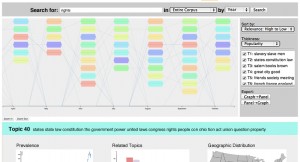 TOME is a tool to support the interactive exploration and visualization of text-based archives, supported by a Digital Humanities Startup Grant from the National Endowment for the Humanities (Lauren Klein and Jacob Eisenstein, co-PIs). Drawing upon the technique of topic modeling—a machine learning method for identifying the set of topics, or themes, in a document set—our tool allows humanities scholars to trace the evolution and circulation of these themes across networks and over time.
TOME is a tool to support the interactive exploration and visualization of text-based archives, supported by a Digital Humanities Startup Grant from the National Endowment for the Humanities (Lauren Klein and Jacob Eisenstein, co-PIs). Drawing upon the technique of topic modeling—a machine learning method for identifying the set of topics, or themes, in a document set—our tool allows humanities scholars to trace the evolution and circulation of these themes across networks and over time.
Link to interactive prototype: http://tome.lmc.gatech.edu/
More information about the prototype can be found on its “About” page.
Publications related to this project include:
- Hayward, A., Bawa, N., Orangi, M., Foster, C., and Klein, L. “TOME: A Topic Modeling Tool for Document Discovery and Exploration.” Proceedings of Digital Humanities 2018. Mexico City, 2018.
- Klein, L., J. Eisenstein, and I. Sun. “Exploratory Thematic Analysis for Digitized Archival Collections.” Digital Scholarship in the Humanities 30.1 (2015).
- Eisenstein, J., I. Sun and L. Klein. “Exploratory Text Analysis for Large Document Archives.’ Proceedings of Digital Humanities 2014. Hamburg: Univ. of Hamburg, 2014.
- Eisenstein, J. and L. Klein. “Reading Thomas Jefferson with TopicViz: Towards a Thematic Method for Exploring Large Cultural Archives.” Proceedings of the Implementing New Knowledge Environments (INKE) Annual Meeting 2012. Vancouver: Scholarly and Research Communication, 2013.
Presentations related to this project include:
-
- “The Carework and Codework of the Digital Humanities.” Digital Humanities Colloquium, University of Georgia, March 2018. Also presented at the Keystone Digital Humanities Conference, Philadelphia, PA, July 2017.
- “Developing and Sustaining Collaborative Research.” Roundtable. Modern Language Association, Austin, TX, January 2016.
- “The Carework and Codework of Nineteenth-Century Abolitionist Newspapers.” The Digital Antiquarian, American Antiquarian Society, May 2015.
- “Beyond the Digital Surrogate: Discovery and Analysis of Digital Collections.” Roundtable. Digital Library Federation Forum, Atlanta, GA, October 2014.
- “The Best-Laid Schemes: Reflections on Three Years of the NEH ODH Data Management Plan Requirement.” Roundtable. Digital Library Federation Forum, Atlanta, GA, October 2014.
- “Exploratory Thematic Analysis for Historical Newspaper Archives.” Institute for Quantitative Theory and Methods. Emory University, April 2015. Also presented at Digital Humanities, Hamburg, Germany, July 2014.
- “Towards a Thematic Method for Exploring Large Cultural Archives,” with Jacob Eisenstein. Research Foundations for Understanding Books and Reading in the Digital Age, Havana, Cuba, December 2012.
Contributors: Lauren Klein, Jacob Eisenstein, Adam Hayward, Nikita Bawa, Morgan Orangi, Caroline Foster, Iris Sun, Catherine Roshelli, Ana Smith.
[…] still remains out of reach. I will illustrate this double function through the example of the TOME project, a digital tool that I’ve been developing with my colleague at Georgia Tech, Jacob […]
[…] still remains out of reach. I will illustrate this double function through the example of the TOME project, a digital tool that I’ve been developing with my colleague at Georgia Tech, Jacob […]
[…] during the Civil War,[10], assess and map language patterns in historical Texas newspapers,[11] trace the evolution and circulation of themes in abolitionist newspapers (and other digital archives),[12] detect poetic content in historical […]
[…] words, that the eye cannot see? Another example: for the past several years, I’ve been working on a project that applies a set of distant reading techniques to a corpus of nineteenth-century aboliti…. I’ve been focused on the issue of gender, and on how the influence of key men and women can be […]